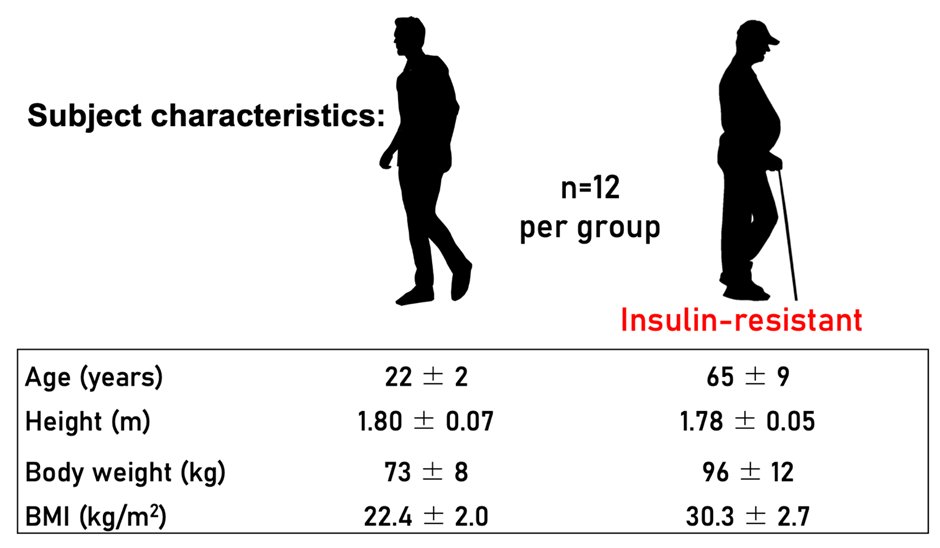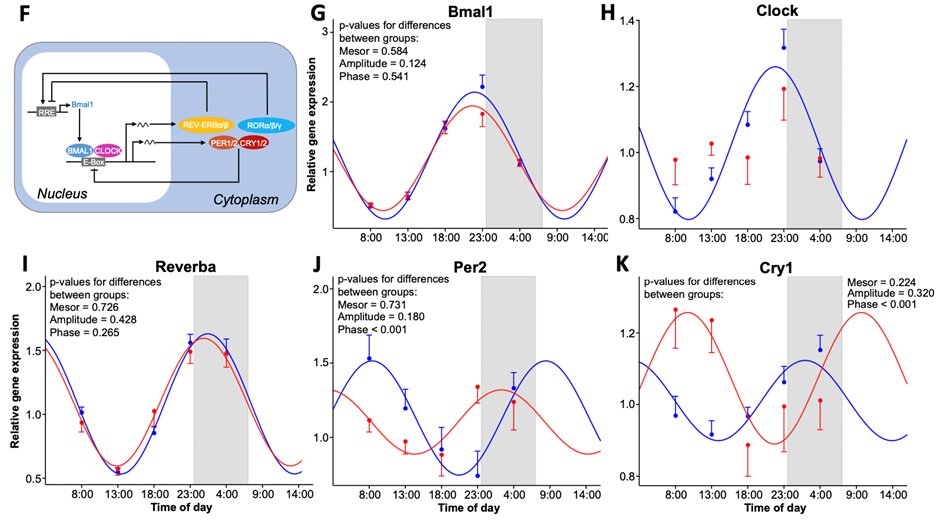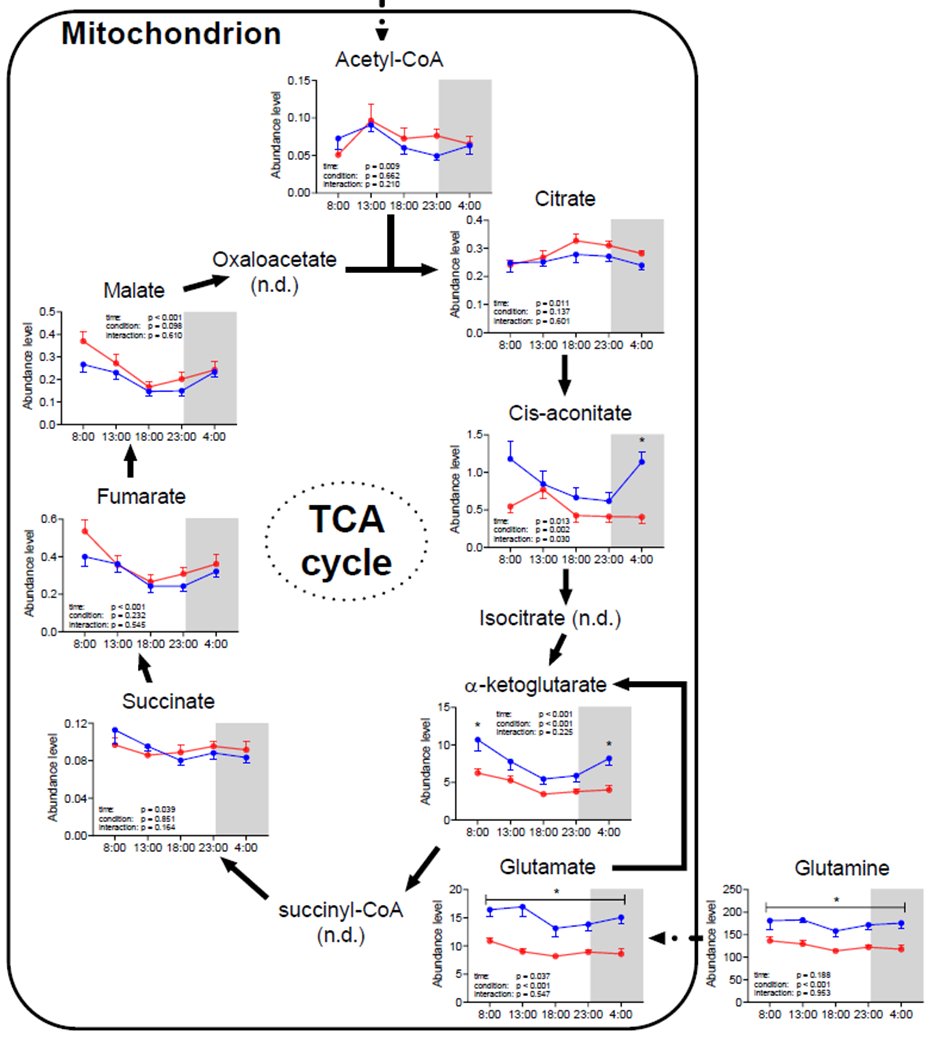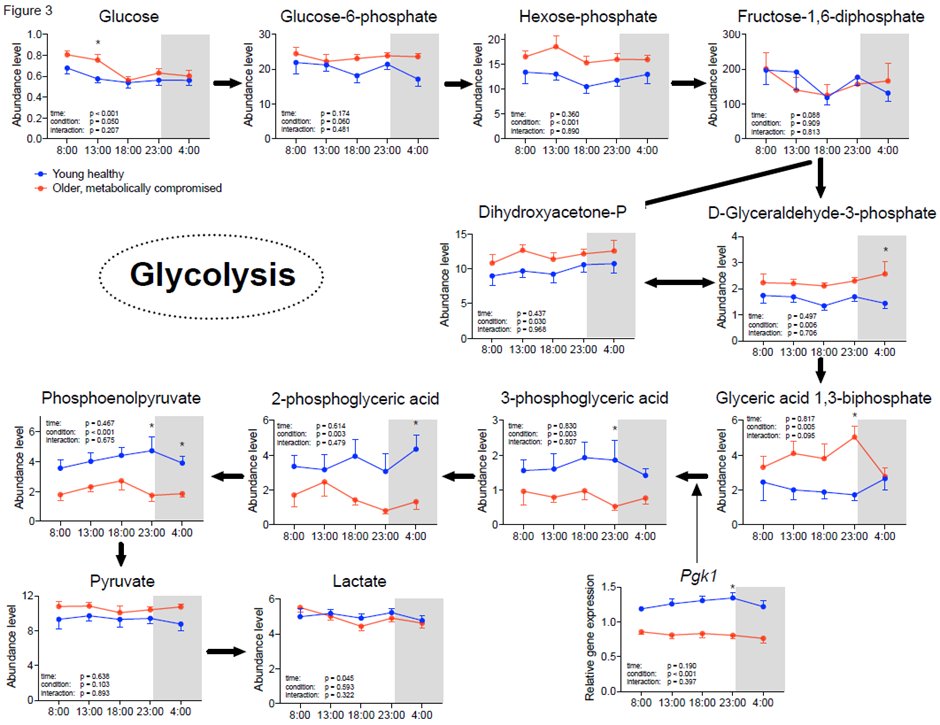
/1
Skeletal muscle does not only have a #circadian clock in 🪰🐭 BUT also in 👨🦱!
Ever wondered how muscle metabolism changes over 24h?
& how about young healthy vs. older metabolically-compromised men?
Then follow this 🧵 on our new work @CellReports
sciencedirect.com/science/articl…
Skeletal muscle does not only have a #circadian clock in 🪰🐭 BUT also in 👨🦱!
Ever wondered how muscle metabolism changes over 24h?
& how about young healthy vs. older metabolically-compromised men?
Then follow this 🧵 on our new work @CellReports
sciencedirect.com/science/articl…
@CellReports /2
To study skeletal muscle metabolism around the clock, we combined data from 2 of our previous human studies with 2 distinct cohorts:
young healthy vs. older metabolically-compromised men
In both cohorts, 5 m. biopsies were taken on a single day:
8AM, 1PM, 6PM, 11PM & 4AM
To study skeletal muscle metabolism around the clock, we combined data from 2 of our previous human studies with 2 distinct cohorts:
young healthy vs. older metabolically-compromised men
In both cohorts, 5 m. biopsies were taken on a single day:
8AM, 1PM, 6PM, 11PM & 4AM

/3
Volunteers received 3 standardized meals & went for a standardized walk 1h after each meal. Before each biopsy, indirect calorimetry was performed to determine energy expenditure & respiratory exchange ratio. Also, blood was drawn bihourly & core temperature @BodyCap measured.
Volunteers received 3 standardized meals & went for a standardized walk 1h after each meal. Before each biopsy, indirect calorimetry was performed to determine energy expenditure & respiratory exchange ratio. Also, blood was drawn bihourly & core temperature @BodyCap measured.

/4
Remarkably, we saw that young healthy men (blue line below) have a ⤵️ respiratory exchange ratio & ⤴️ free fatty acid levels compared to older metabolically-compromised men (red line) during the night, suggesting ⤵️ capability of switching to fat oxidation during the night.
Remarkably, we saw that young healthy men (blue line below) have a ⤵️ respiratory exchange ratio & ⤴️ free fatty acid levels compared to older metabolically-compromised men (red line) during the night, suggesting ⤵️ capability of switching to fat oxidation during the night.

/5
#circadian clock genes in muscle show distinct patterns between cohorts:
While Bmal1 & Reverba cycle in synchrony over 24h, Per2 & Cry1 both shifted phase (peak occurred at another time) & Clock did not display a 24h-rhythm anymore in older metabolically-compromised men.
#circadian clock genes in muscle show distinct patterns between cohorts:
While Bmal1 & Reverba cycle in synchrony over 24h, Per2 & Cry1 both shifted phase (peak occurred at another time) & Clock did not display a 24h-rhythm anymore in older metabolically-compromised men.

/7
Triggered by these changes in the respiratory exchange ratio and within the skeletal muscle clock, we wanted to know more about what happens in skeletal muscle metabolism around the clock!
That is why we performed semi-targeted metabolomics on all muscle samples…
Triggered by these changes in the respiratory exchange ratio and within the skeletal muscle clock, we wanted to know more about what happens in skeletal muscle metabolism around the clock!
That is why we performed semi-targeted metabolomics on all muscle samples…
/8
From the 115 metabolites that we identified over all samples, 64 metabolites (~56%) displayed altered mean abundance levels between groups and the majority of these metabolites had lower levels in older metabolically-compromised (OMC) compared to young healthy (YH) men.
From the 115 metabolites that we identified over all samples, 64 metabolites (~56%) displayed altered mean abundance levels between groups and the majority of these metabolites had lower levels in older metabolically-compromised (OMC) compared to young healthy (YH) men.

/9
Overall, we also identified the night period (4AM) as the time window of greatest disparity between groups.
Below you see the amount of metabolites that were different between groups at the respective time of day:
Overall, we also identified the night period (4AM) as the time window of greatest disparity between groups.
Below you see the amount of metabolites that were different between groups at the respective time of day:

/10
In terms of 24h-rhythmicity, we found metabolites associated with the TCA cycle to be mostly rhythmic, with most metabolites peaking after the overnight fast at 8AM.
In terms of 24h-rhythmicity, we found metabolites associated with the TCA cycle to be mostly rhythmic, with most metabolites peaking after the overnight fast at 8AM.

/11
Metabolites associated with glycolysis were stable over 24h and displayed differences between groups.
While metabolites associated with initial steps of glycolysis had higher levels in older-metabolically -compromised men, later steps had higher levels in young healthy men.
Metabolites associated with glycolysis were stable over 24h and displayed differences between groups.
While metabolites associated with initial steps of glycolysis had higher levels in older-metabolically -compromised men, later steps had higher levels in young healthy men.

/12
We also found 24h-rhythmicity in transcript levels of key regulators of glucose and lipid metabolism.
For example, Slc2a4, which expresses the GLUT4 receptor in muscle, clearly peaked at 13:00.
We also found 24h-rhythmicity in transcript levels of key regulators of glucose and lipid metabolism.
For example, Slc2a4, which expresses the GLUT4 receptor in muscle, clearly peaked at 13:00.

/13
In general, we demonstrate that a great proportion of the muscle metabolome follows a 24h rhythm.
In this context, we identify specific metabolites that are only rhythmic in one of the two groups…
In general, we demonstrate that a great proportion of the muscle metabolome follows a 24h rhythm.
In this context, we identify specific metabolites that are only rhythmic in one of the two groups…

/14
From the 38 metabolites that were rhythmic in both groups, ß-hydroxybutyrate and hippuric acid had a higher amplitude in their 24h rhythm in young healthy men.
From the 38 metabolites that were rhythmic in both groups, ß-hydroxybutyrate and hippuric acid had a higher amplitude in their 24h rhythm in young healthy men.

/15
ß-hydroxybutyrate stood out as its abundance levels were correlated with the respiratory exchange ratio, suggesting that higher ß-hydroxybutyrate levels in muscle are associated with fat oxidation on the whole body level.
ß-hydroxybutyrate stood out as its abundance levels were correlated with the respiratory exchange ratio, suggesting that higher ß-hydroxybutyrate levels in muscle are associated with fat oxidation on the whole body level.

/16
Also from these 38 metabolites, we identified 3 metabolites that were clearly phase-shifted between groups:
Also from these 38 metabolites, we identified 3 metabolites that were clearly phase-shifted between groups:

/17
Conclusion 1:
• The muscle metabolome vastly changes over 24h
• Large divergence in the skeletal muscle metabolome between YH and OMC men
• Muscle metabolome was most different at night
• Considerable % of differences would've been missed by single time point analysis
Conclusion 1:
• The muscle metabolome vastly changes over 24h
• Large divergence in the skeletal muscle metabolome between YH and OMC men
• Muscle metabolome was most different at night
• Considerable % of differences would've been missed by single time point analysis
/18
Conclusion 2:
Changes within the temporal remodeling of the muscle metabolome could contribute to the disturbed molecular clock in metabolically-compromised individuals & their blunted ability for metabolic switching between carbohydrate & fat oxidation over the 24 h cycle!
Conclusion 2:
Changes within the temporal remodeling of the muscle metabolome could contribute to the disturbed molecular clock in metabolically-compromised individuals & their blunted ability for metabolic switching between carbohydrate & fat oxidation over the 24 h cycle!
/19
🙏 to all co-authors!
My supervisors: @SchrauwenP @JorisHoeks & Matthijs Hesselink
Our collaborators:
• Metabolomics analyses: @rhhoutkooper @mvanweeghel & George Janssens
• 24h statistics: @RexParsons8
Former colleagues: Jakob Wefers, Dirk van Moorsel & Jan Hansen
🙏 to all co-authors!
My supervisors: @SchrauwenP @JorisHoeks & Matthijs Hesselink
Our collaborators:
• Metabolomics analyses: @rhhoutkooper @mvanweeghel & George Janssens
• 24h statistics: @RexParsons8
Former colleagues: Jakob Wefers, Dirk van Moorsel & Jan Hansen
/20
For whom this thread could be of interest:
@hubermanlab @SatchinPanda @JuleenRZierath @kaesser @JohnAHawley @JCedernaes @martamurgia @atul_deshmukh1 @MilenaSchonke @DrBMGabriel @DrBSteamjets @mattiaquattro @Matt_Muscle_Guy
Retweets of the starting tweet are appreciated!
For whom this thread could be of interest:
@hubermanlab @SatchinPanda @JuleenRZierath @kaesser @JohnAHawley @JCedernaes @martamurgia @atul_deshmukh1 @MilenaSchonke @DrBMGabriel @DrBSteamjets @mattiaquattro @Matt_Muscle_Guy
Retweets of the starting tweet are appreciated!
@threadreaderapp unroll
• • •
Missing some Tweet in this thread? You can try to
force a refresh







